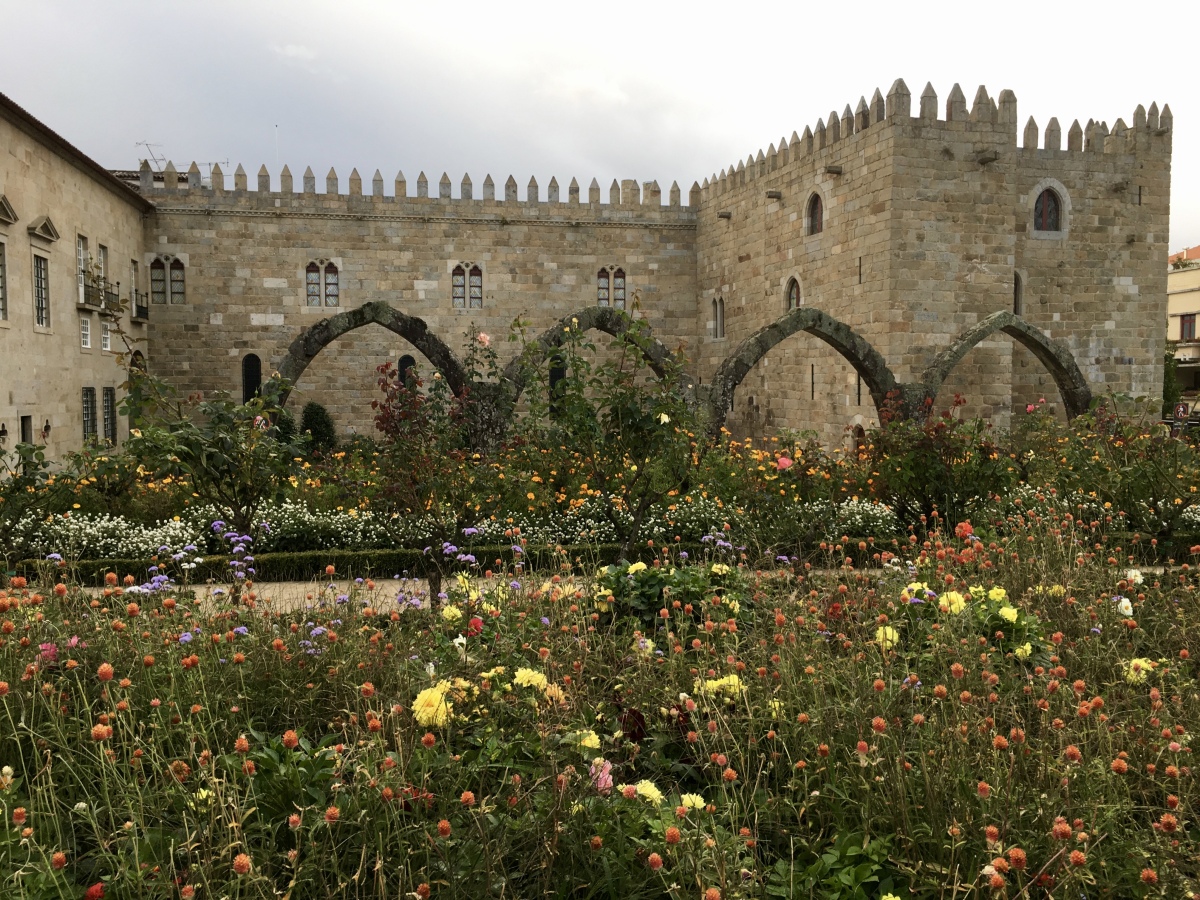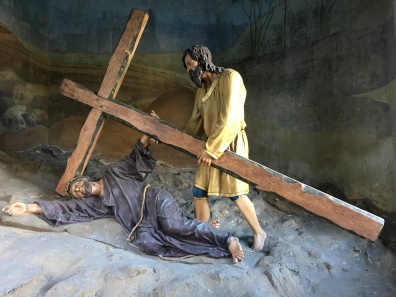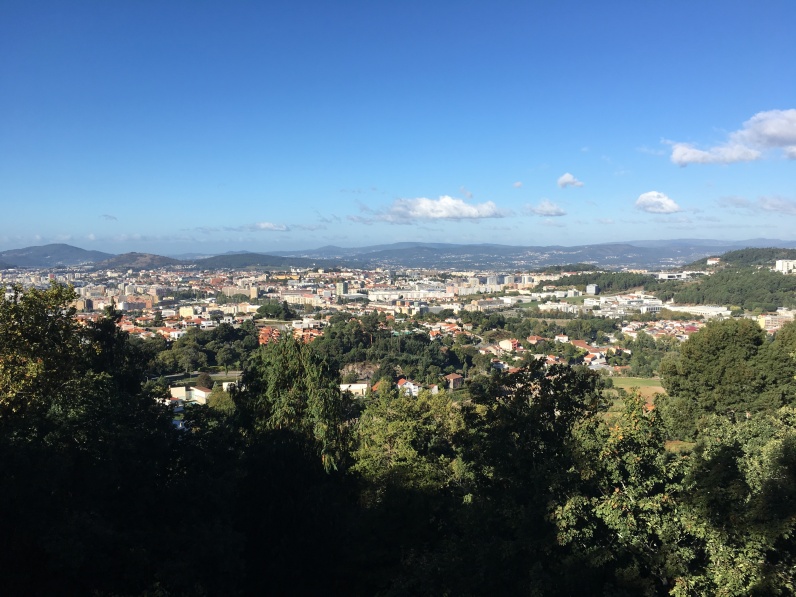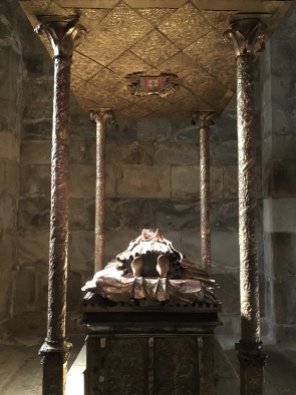A full late-October day in Braga, Portugal. A day fortified with a breakfast of eggs, meats, cheeses, pastries, orange juice and coffee served by our lovely hostess, Conceição, at Domus 26 Guesthouse. A day switch-backing up a mountain with my husband in a rented MINI Clubman on narrow roads lined with colorful houses; a blue-sky day that refrained from raining. A day attempting to escape hordes of Chinese tourists at the pilgrimage site of Bom Jesus do Monte, a remake of Jerusalem’s Golgotha, by hiding inside a man-made grotto; a day descending and climbing the baroque tiered staircases dating from different 18th century decades and lined with stations of the cross. A day encountering statues with water gurgling out of eyes, ears, noses, and mouths on the lower Escadaria dos Cinco Sentidos (Stairway of the Five Senses). A day meeting face-to-face with Faith, Hope and Charity on the highest Escadaria das Trés Virtudes (Stairway of the Three Virtues). A day meandering through the park, hotels, tennis courts, flower gardens and lakes and then driving further up to the neo-classical sanctuary and Marian shrine of Nossa Senhora do Sameiro. A day admiring sweeping views of Braga and sitting on azulejo benches at Sameiro.
A day wandering through the oldest cathedral in Portugal, Sé de Braga, with its mishmash of Romanesque, Manueline and baroque styles. A day finding satyrs and mermen holding up twin baroque organs and cloisters disclosing Gothic chapels. A day, a moment really, paying homage at the tomb of the Infant D. Afonso, coated with gilded and silver copper.
A day forgetting we were in Portugal as we mistakenly blurted Spanish words. A day marching around the elegant town center with its ancient buildings, narrow lanes and plazas, past the Fountain of the Castles, among candy-colored and azulejo-covered buildings. A day dipping into trim boutiques and buying scarves. A day leaning on the blue doors of the azulejo-tiled Palácio do Raio, built when John V reigned. A day strolling through geometrically carved boxwoods, cedar topiaries, and a sea of flowers at Jardin de Santa Bárbara to the broken arcade ruins of the Paço Arcebispal dos Braganças.
A day drinking beers in a dark bar; a day savoring delicious sea bass with vinho verde at Restaurante O Jacó, known for its meat, while Mike chewed relentlessly on grisly braised beef loin medallions. A day that would be our last in Braga, as we headed to Porto by way of Guimarães on Sunday.
Steps: 14,904 (6.32 miles)
*Saturday, October 27, 2018*
See below for historical facts and figures, if you’re interested. 🙂
*********

me & Conceição at Domus 26 Guesthouse in Braga
Bom Jesus do Monte is a famous pilgrimage site outside of Braga. It has a monumental, Baroque stairway that climbs 116 meters (381 feet). It stands on a forested hill that offers grand views across the city. The new church (built 1784–1834) was one of the first neoclassical churches of Portugal.

Bom Jesus do Monte
Escadaria do Bom Jesus

Escadaria do Bom Jesus

Mike at Escadaria do Bom Jesus

me at Escadaria do Bom Jesus
The neoclassical Nossa Senhora do Sameiro, or Sanctuary of Our Lady of Sameiro, is the largest Marian devotional shrine in Portugal, second only to the Sanctuary of Fátima. Construction was begin in 1863.

Nossa Senhora do Sameiro
The 1089 Sé de Braga is the oldest in Portugal; it was declared a National Monument in 1910. The interior includes a sacristy, Treasury Museum and the chapels of São Geraldo and Glória (Chapel of the Glory, built 1326 – 1348). The Capela dos Reis (Chapel of the Kings), was built around 1374 in the place where Count Henrique and Countess Theresa, parents of the first Portuguese King, were buried. Their tombs were substituted in the early 16th century by new ones, with recumbent figures. The cathedral’s choir is beautifully decorated with a painted ceiling and sculptured gilt wood choir stalls (1737). In front of the high choir there are two gilt wood organs, carved in the 1730s, heavily decorated with baroque and fantastic motifs.

Sé de Braga
Largo do Paço represents the seat of the Republic of Braga, extinct in 1790 by the order of the first Queen of Portugal, María I. The central fountain is from 1723.

Largo do Paço

Colorful streets of Braga
The small Palácio do Raio was built from 1753-54. It is an example of the late Baroque, early Rococo style of decoration by Portuguese architect André Soares, notable for his influence in the northern Baroque movement.

Palácio do Raio
Igreja do Hospital de San Marcos dates back to the 18th century. Life-size statues of the apostles define the upper rampart. In the middle of the church façade, there is a niche containing a statue of Saint Mark. On the same site, there was a church and hospital that Diogo de Sousa had built in the 16th century. The hospital provided relief to the poor, pilgrims and travelers staying in the city of Braga.

Igreja do Hospital de San Marcos
Outside the spiky, medieval north wing of the Paço Arcebispal dos Braganças, begun in the 14th century and enlarged in the 17th & 18th centuries, is the 17th century square known as Jardin de Santa Bárbara. The building is now home to university offices and the municipal library.
Jardin de Santa Bárbara

Jardin de Santa Bárbara

public building in Braga
West of the old center sits the elegant 18th century “arch of the new gate,” the Arco da Porto Nova, which once served as the city’s main entry. It displays the coat of arms of the archbishop who commissioned it, Dom José de Bragança.

Arco da Porto Nova
Conceição recommended Restaurante O Jacó, which she said was well-known for its meat. My fish meal was great, but Mike’s meat was very gristly and chewy.

Grilled sea bass at Restaurante O Jacó
**********************
“PROSE” INVITATION: I invite you to write up to a post on your own blog about a recently visited particular destination (not journeys in general). Concentrate on any intention you set for your prose. In this case, one of my intentions for my trip to Portugal was to pick five random verbs each day and use them in my travel essay: reign, rain, disclose, attempt, march. √
It doesn’t matter whether you write fiction or non-fiction for this invitation. You can either set your own writing intentions, or use one of the prompts I’ve listed on this page: writing prompts: prose. (This page is a work in process.) You can also include photos, of course.
Include the link in the comments below by Monday, March 25 at 1:00 p.m. EST. When I write my post in response to this invitation on Tuesday, March 26, I’ll include your links in that post.
This will be an ongoing invitation. Feel free to jump in at any time. 🙂
I hope you’ll join in our community. I look forward to reading your posts!
the ~ wander.essence ~ community
I invite you all to settle in and read a few posts from our wandering community. I promise, you’ll be inspired. 🙂
- Jo, of Restless Jo, wrote a revealing post about her struggle to acclimate to a new culture in her newly adopted home in the Algarve.
Thanks to all of you who wrote prosaic posts following intentions you set for yourself. 🙂












































Sounds, and looks, like the perfect day, Cathy (apart from Mike’s meat 🙂 ). The photos are superb. Love your hide and seek in the grotto, and those benches are lovely! Thanks so much for including my link. I’m happy to say that I do feel I’ve moved on from there. 🙂 🙂
LikeLike
I couldn’t believe Mike’s meal was so bad when the restaurant was so highly recommended by our Airbnb host for its MEAT. It seems their seafood was better. It was fun trying to elude the Chinese tourists, which seem to be everywhere these days.
I figured it would only be a matter of time before you moved on from that feeling you expressed in that post, Jo. I’m glad you’re happy as can be now! 🙂
LikeLiked by 1 person
Wow – Braga is so beautiful! Your blog is constantly inspiring me to add new destinations to my dream travel list!
LikeLike
I’m glad you found inspiration here, Marsi. Braga was really beautiful, and there’s so much to see!
LikeLiked by 1 person
Braga is wonderful (as shown by your photos) – so much history!
LikeLike
Yes, lots of history, yet I must admit I don’t really know much of Portuguese history. 🙂
LikeLiked by 1 person
Me neither, but I do like old places.
LikeLiked by 1 person
A day with a lot packed into it.
What a beautiful town!
LikeLike
I thought so too. It was my first full day after all my Camino stuff was over. 🙂
LikeLiked by 1 person
Cathy your post wants me to go back to Portugal for a third time 🙂 Lovely photos!
LikeLike
Have you been to Braga, Suzanne? That was my first time. So many places to go. What is your favorite?
LikeLiked by 1 person
Cathy, no we only got as far as Porto. I do hope to get back one day. Who knows! My favourite hard to say as we loved Porto, parts of Lisbon and the small countryside villages in the area where we housesat. Not far from Faro. The coastal area is interesting. Though I come from NZ and we are very spoilt for beautiful coastal areas. Which we enjoyed this morning 🙂 I would love to do a walk similar to what you did as I mentioned previously. Excellent write up about your travels in Portugal.
LikeLike
I always enjoy the smaller villages most, Suzanne. Braga was a good size; we also went to Amarante and Obidos, which we loved. Thanks so much for reading and for your nice comment.
As for New Zealand, I’m so sorry to hear about the violence there this morning.
LikeLike
Thanks Cathy. I think as a country we are all still in shock!! So senseless and just downright evil!!
LikeLike
How right you are! And to think he got his inspiration from our despicable president makes my blood boil.
LikeLiked by 1 person
Cathy I think the media may be stirring the pot. I have no interest in knowing what he wrote. What is more shocking is the amount of Right Wing Organisations around the world!!
LikeLike
I honestly don’t blame the media because I live with this stuff every day here in America since he was elected (NOT BY ME, mind you!). Yes, the right-wingers are gaining traction, and it’s very upsetting. I can’t believe we fought against this kind of ideology in WWII and that it is rising again.
LikeLiked by 1 person
One reason for the right-wingers gaining traction is that after 9/11 the focus was on the Isis and their extremists. Many leaders especially in Europe are mostly right wing. Sadly, many of us humans never seem to learn and have a very short memory.
LikeLiked by 1 person
Wow, so many beautiful buildings in this post. And I love the blue tiles. Portugal is high on my destination wish list.
LikeLike
It’s a beautiful city, Carol. I hope you make it to Portugal, but I sure hope your weather is better than ours was on this trip. 🙂
LikeLiked by 1 person
Looks like a perfect day with time to wander, take pix, eat and enjoy the sunshine. The buildings look amazing.
LikeLike
It was a wonderful day, Mari, and one of the best weather-wise that we had. We had a lot of gloomy weather on this trip. 🙂
LikeLike
Portugal is a potential honeymoon destination for me! Thank you for the detailed post!
LikeLike
How exciting you have a honeymoon coming up! I think Portugal is a great destination for such. I hope you have better weather than we did! 🙂
LikeLike
I enjoyed Braga …such wonderful travels Cathy …I am fond of Portugal and my Portuguese friends …thanks for sharing 🤓💫☀️
LikeLike
Thanks for dropping by, Hedy. I loved Braga and overall our whole trip to Portugal, except for some bad weather days! It is a lovely country. 🙂
LikeLiked by 1 person